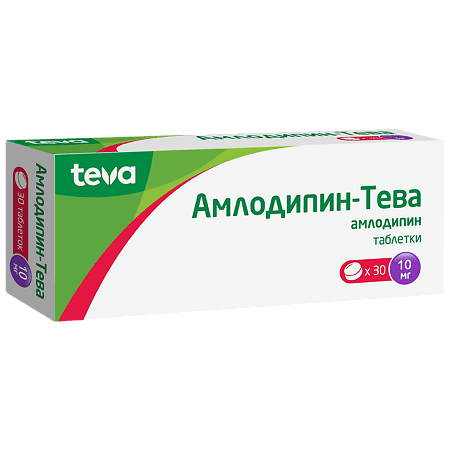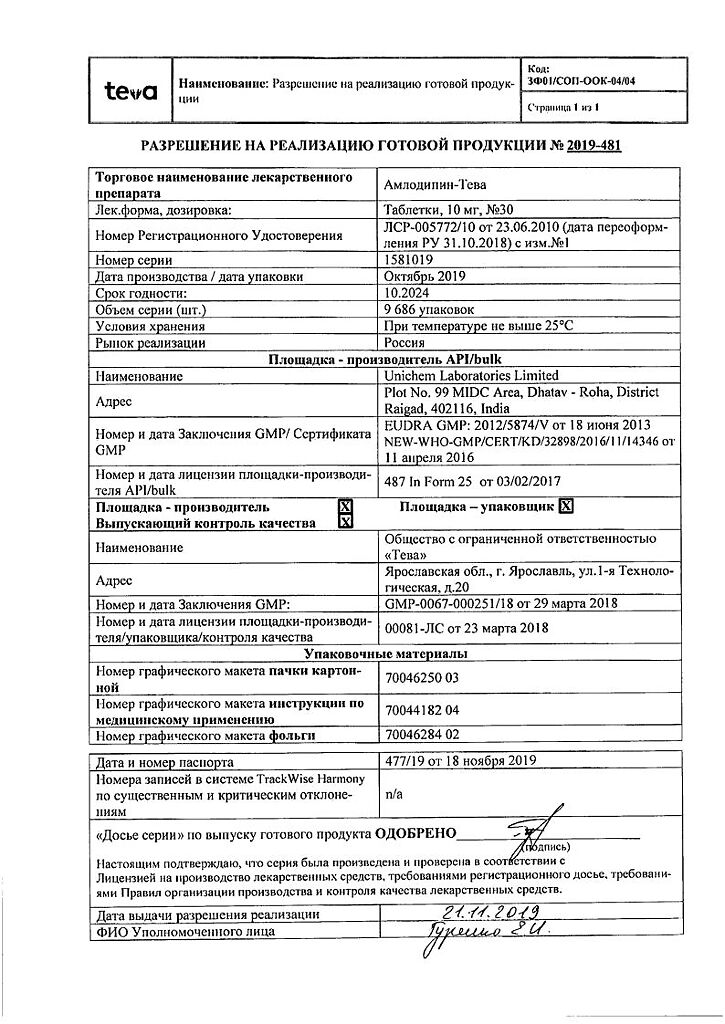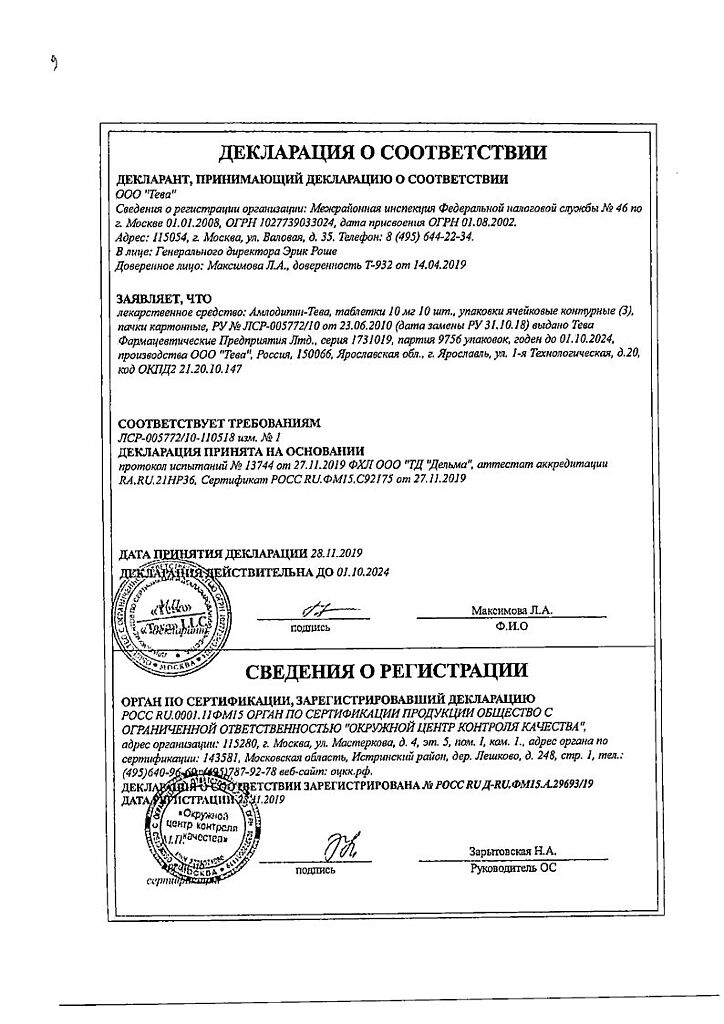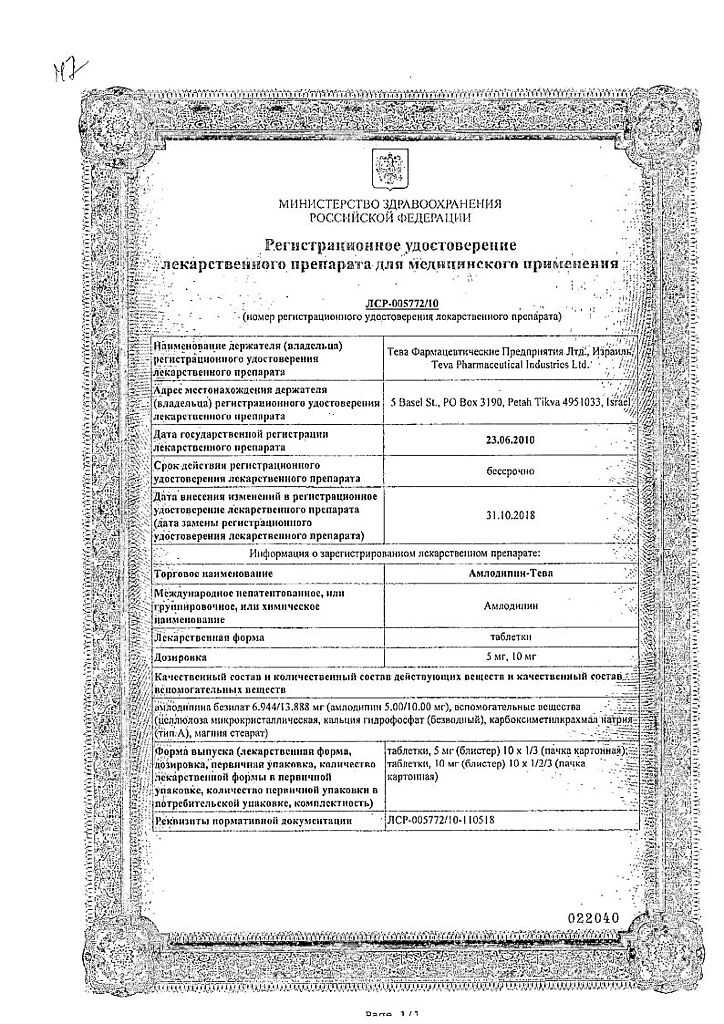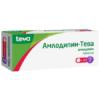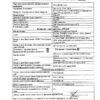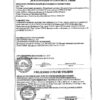No products in the cart.
Amlodipine-Teva, tablets 10 mg 30 pcs
€1.00
Out of stock
(E-mail when Stock is available)
Description
Slow calcium channel blocker (SCB). Dihydropyridine derivative – II generation “slow” calcium channel blocker.
It has antianginal and hypotensive effects. It blocks calcium channels, reduces transmembrane transition of calcium ions into the cell (more in vascular smooth muscle cells than in cardiomyocytes).
The antianginal action is caused by the dilation of coronary and peripheral arteries and arterioles: in angina pectoris it reduces myocardial ischemia; by dilation of peripheral arterioles it reduces total peripheral resistance of vessels (TPRV), reduces post-load of the heart, reduces myocardial oxygen demand.
Dilating coronary arteries and arterioles in unchanged and in ischemic areas of the myocardium, increases the flow of oxygen to the myocardium (especially in vasospastic angina); prevents spasm of coronary arteries (including those caused by smoking).
In patients with stable angina a single daily dose increases exercise tolerance, increases time to angina attack and “coronary” ST-segment depression, reduces the frequency of angina attacks and consumption of nitroglycerin and other nitrates.
It has a long-term dose-dependent hypotensive effect. The hypotensive effect is due to a direct vasodilatory effect on the vascular smooth muscles. In arterial hypertension a single dose provides clinically significant reduction of blood pressure (BP) for 24 hours. (in patient’s “lying” and “standing” position). Orthostatic hypotension when prescribing amlodipine is quite rare. It does not cause decrease in left ventricular ejection fraction. It reduces the degree of left ventricular myocardial hypertrophy. It does not affect myocardial contractility and conduction, does not cause a reflex increase in heart rate (HR), inhibits platelet aggregation, increases glomerular filtration rate, has a weak natriuretic effect.
In diabetic nephropathy it does not increase the severity of microalbuminuria. It has no adverse effect on metabolism and concentration of blood plasma lipids and may be used for therapy of patients with bronchial asthma, diabetes mellitus and gout. Significant decrease in BP is observed after 6-10 hours, the duration of effect is 24 hours.
. In patients with diseases of the cardiovascular system, including coronary atherosclerosis with lesion of one vessel and up to stenosis of 3 or more arteries, atherosclerosis of carotid arteries, having had a myocardial infarction, percutaneous transluminal angioplasty (TLAP) of coronary arteries or patients with angina pectoris, the use of amlodipine prevents the development of intima-media thickening of carotid arteries, reduces mortality from myocardial infarction, stroke, TLAP, aorto-coronary bypass surgery; leads to a decrease in the incidence of unstable angina and progression of chronic heart failure (CHF); reduces the frequency of interventions aimed at restoring coronary blood flow.
Does not increase risk of death or complications and lethal outcomes in patients with CHF (functional class III – IV according to NYHA classification) during therapy with digoxin, diuretics and angiotensin-converting enzyme inhibitors (ACE). In patients with CHF (functional class III – IV according to NYHA classification) of non-ischemic etiology during amlodipine use there is a possibility of pulmonary edema development.
Indications
Indications
Arterial hypertension (both in monotherapy and in combination with other antihypertensive drugs).
Stable angina and vasospastic angina (Prinzmetal’s angina or variant angina), both in monotherapy and in combination with other antianginal drugs.
Pharmacological effect
Pharmacological effect
Pharmacotherapeutic group: blocker of “slow” calcium channels.
ATX code: C08CA01
Pharmacological properties
Pharmacodynamics
Blocker of “slow” calcium channels (SCMC) L-type from the group
1,4-dihydropyridine has antianginal and antihypertensive effects. Due to the blockade of “slow” calcium channels, it reduces the transmembrane transition of calcium ions into the cell (more into vascular smooth muscle cells than into cardiomyocytes).
The antianginal effect is due to the expansion of coronary and peripheral arteries and arterioles:
in case of angina pectoris, it reduces the severity of myocardial ischemia; expanding peripheral arterioles, reduces total peripheral vascular resistance, reduces afterload on the heart, reduces myocardial oxygen demand;
expanding the coronary arteries and arterioles in unchanged and ischemic areas of the myocardium, increases the supply of oxygen to the myocardium (especially with vasospastic angina); prevents spasm of the coronary arteries (including those caused by smoking).
In patients with stable angina, a single daily dose increases exercise tolerance, slows the development of angina attacks and “ischemic” depression of the ST segment, reduces the frequency of angina attacks and the consumption of nitroglycerin and other nitrates.
It has a long-term dose-dependent antihypertensive effect due to a direct vasodilating effect on vascular smooth muscle. For arterial hypertension, a single dose provides a clinically significant reduction in blood pressure (BP) over 24 hours (with the patient lying and standing).
Orthostatic hypotension when prescribing amlodipine is quite rare. Amlodipine does not cause a decrease in exercise tolerance, does not cause a decrease in left ventricular ejection fraction, and reduces the degree of left ventricular myocardial hypertrophy. The drug has no effect on myocardial contractility and conductivity, does not cause a reflex increase in heart rate (HR), moderately inhibits platelet aggregation, increases the glomerular filtration rate, and has a weak natriuretic effect.
In diabetic nephropathy, it does not increase the severity of microalbuminuria. It does not have any adverse effect on metabolism and plasma lipid concentrations and can be used in the treatment of patients with bronchial asthma, diabetes mellitus and gout. A significant decrease in blood pressure is observed after
6-10 hours, effect duration – 24 hours.
In patients with diseases of the cardiovascular system (including coronary atherosclerosis with damage to one vessel and up to stenosis of 3 or more arteries, atherosclerosis of the carotid arteries), who have had myocardial infarction, percutaneous transluminal coronary angioplasty (PTCA) or in patients with angina pectoris, the use of amlodipine prevents the development of intima-media thickening of the carotid arteries; reduces mortality from myocardial infarction, stroke, PTCA, coronary artery bypass grafting; leads to a decrease in the number of hospitalizations for unstable angina and progression of chronic heart failure (CHF); reduces the frequency of interventions aimed at restoring coronary blood flow.
It does not increase the mortality rate or the development of complications and deaths in patients with CHF (III-IV functional class according to the NYHA classification) during therapy with digoxin, diuretics and angiotensin-converting enzyme (ACE) inhibitors. In patients with CHF (III-IV functional class according to the NYHA classification) of non-ischemic etiology, when using amlodipine, there is a risk of pulmonary edema.
Pharmacokinetics
Suction. After oral administration, amlodipine is slowly absorbed from the gastrointestinal tract. The average absolute bioavailability is 64%, the maximum concentration (Cmax) in the blood serum is observed after 6-12 hours. Equilibrium concentrations are achieved after 7-8 days of therapy.
Food intake does not affect the absorption of amlodipine.
Distribution. The mean volume of distribution is 21 L/kg body weight, indicating that most of the drug is in the tissues and a smaller part is in the blood. Most of the drug in the blood (97.5%) binds to blood plasma proteins.
Metabolism. Amlodipine undergoes slow but active metabolism in the liver with no significant first-pass effect through the liver. Metabolites do not have significant pharmacological activity.
Excretion. After a single dose, the half-life (T½) varies from 35 to
50 hours, with repeated use T½ is approximately 45 hours. About 60% of the dose taken orally is excreted by the kidneys mainly in the form of metabolites, 10% unchanged, and 20-25% through the intestines with bile. The total clearance of amlodipine is 0.116 ml/s/kg (7 ml/min/kg; 0.42 l/h/kg).
In elderly patients (over 65 years of age), the elimination of amlodipine is slower (T½ – 65 hours) compared to young patients, but this difference is not clinically significant.
Prolongation of T½ in patients with liver failure suggests that with long-term use the accumulation of the drug in the body will be higher (T½ – up to 60 hours).
Renal failure does not significantly affect the kinetics of amlodipine. In patients with impaired renal function, changes in plasma concentrations of amlodipine do not correlate with the degree of renal failure.
Amlodipine penetrates the blood-brain barrier. It is not removed by hemodialysis.
Special instructions
Special instructions
Cardiovascular diseases
The effectiveness and safety of amlodipine in hypertensive crisis has not been established.
In acute myocardial infarction, the use of amlodipine is possible only after stabilization of hemodynamic parameters. In rare cases, patients with coronary artery disease (especially with severe obstructive coronary artery disease) have experienced an increase in the frequency, duration and/or severity of angina attacks after starting the use of BMCC or after increasing their dosage.
Although BMCC should generally be used with caution in patients with chronic heart failure, amlodipine did not increase mortality or the incidence of cardiovascular events in patients with chronic heart failure (CHF) in short- and long-term clinical studies. During the use of amlodipine in patients with CHF (III and IV functional class according to the NYHA classification) of non-ischemic origin, an increase in the incidence of pulmonary edema was observed, despite the absence of signs of progression of heart failure.
Aortic stenosis / mitral stenosis / hypertrophic obstructive cardiomyopathy
As with all drugs that have a vasodilating effect, amlodipine should be used with caution in patients with aortic stenosis, mitral stenosis or hypertrophic obstructive cardiomyopathy. In patients with left ventricular outflow tract obstruction (for example, severe aortic stenosis), the use of the drug is not recommended.
Withdrawal syndrome
Despite the absence of withdrawal syndrome in BMCC, it is advisable to discontinue treatment with amlodipine by gradually reducing the dose of the drug. Amlodipine does not prevent the development of withdrawal syndrome after abrupt cessation of beta-blockers.
Peripheral edema
Mild to moderate peripheral edema was the most common adverse event of amlodipine in clinical studies. The incidence of peripheral edema increases with increasing dose (when using amlodipine at a dose of 2.5 mg, 5 mg and 10 mg per day, edema occurred in 1.8%, 3% and 10.8% of patients, respectively). Peripheral edema associated with the use of amlodipine should be carefully differentiated from symptoms of progression of left ventricular heart failure.
Liver dysfunction
Controlled studies have not been conducted in patients with impaired liver function. In a small number of patients with mild to moderate liver failure, an increase in T1/2 of amlodipine was noted. Patients with liver failure, if it is necessary to use amlodipine, should be under medical supervision. In some cases (for example, with moderate liver failure), the use of a lower initial dose of amlodipine (2.5 mg per day) is recommended.
Old age
In elderly patients, T1/2 may increase and amlodipine clearance may decrease. In clinical studies, the incidence of adverse events in patients aged ≥ 65 years was approximately 6% higher than in younger patients.
Dose changes are not required, but more careful monitoring of patients in this category is necessary.
Other
During amlodipine therapy, it is necessary to monitor body weight and salt intake, and prescribing an appropriate diet is indicated.
It is necessary to maintain dental hygiene and follow-up with a dentist (to prevent pain, bleeding and gum hyperplasia).
Impact on the ability to drive vehicles and machinery
Although no negative effects on the ability to drive vehicles or other complex mechanisms were observed while taking the drug Amlodipine-Teva, however, due to a possible excessive decrease in blood pressure, the development of dizziness, drowsiness and other adverse reactions, caution should be exercised in these situations, especially at the beginning of treatment and when increasing the dose.
Active ingredient
Active ingredient
Amlodipine
Composition
Composition
1 tablet contains:
active ingredient: amlodipine besilate (amlodipine) – 6.944 mg/13.888 mg (5.00 mg/10.00 mg);
excipients: microcrystalline cellulose (type 102) – 127.056 mg/254.112 mg, calcium hydrogen phosphate (anhydrous) – 60.00 mg/120.00 mg, sodium carboxymethyl starch (type A) – 4.00 mg/8.00 mg, magnesium stearate – 2.00 mg/4.00 mg.
Pregnancy
Pregnancy
Pregnancy
The safety of amlodipine during pregnancy has not been studied. In animal studies, reproductive toxicity was observed when large doses of amlodipine were used. Use during pregnancy is recommended only when safe alternatives are not available and when the benefit to the mother outweighs the potential risk to the fetus.
Breastfeeding period
Experience with the drug shows that amlodipine is excreted into women’s breast milk. The mean milk/plasma ratio for amlodipine concentration was 0.85 among 31 lactating women who had pregnancy-related hypertension and received amlodipine at an initial dosage of 5 mg per day. The dosage of the drug was adjusted if necessary (depending on the average daily dose and weight: 6 mg and 98.7 mcg/mg, respectively). The estimated daily dose of amlodipine received by an infant through breast milk is 4.17 mcg/kg.
Fertility
In studies in rats, undesirable effects of amlodipine on male fertility were noted. Reversible biochemical changes in sperm heads were noted in some patients taking BMCC. Clinical data regarding the potential effects of amlodipine on fertility are insufficient.
Contraindications
Contraindications
Hypersensitivity to amlodipine, other dihydropyridine derivatives, as well as excipients included in the drug.
Severe arterial hypotension (systolic blood pressure less than 90 mm Hg).
Left ventricular outflow tract obstruction (including severe aortic stenosis).
Shock (including cardiogenic).
Hemodynamically unstable heart failure after myocardial infarction.
Age up to 18 years (efficacy and safety have not been established).
Breastfeeding period.
With caution
In patients with liver failure, CHF of non-ischemic etiology
III-IV functional class according to the NYHA classification, unstable angina, aortic stenosis, mitral stenosis, hypertrophic obstructive cardiomyopathy, acute myocardial infarction (and within 1 month after it), sick sinus syndrome (severe tachycardia, bradycardia), arterial hypotension, when used simultaneously with inhibitors or inducers of the CYP3A4 isoenzyme, during pregnancy, in elderly patients.
Side Effects
Side Effects
The frequency of side effects is given in accordance with the following gradation (World Health Organization classification): very often (≥ 1/10), often
(≥ 1/100, < 1/10), uncommon (≥ 1/1000, < 1/100), rare (≥ 1/10000, < 1/1000), very rare (< 1/10000), frequency unknown (frequency cannot be estimated from available data).
Disorders of the blood and lymphatic system: very rarely – leukopenia, thrombocytopenia.
Immune system disorders: very rarely – allergic reactions, angioedema.
Metabolic and nutritional disorders: uncommon – weight loss, weight gain, taste perversion; very rarely – hyperglycemia.
Mental disorders: infrequently – insomnia, emotional lability, depression, anxiety; rarely – confusion.
Nervous system disorders: often – headache (especially at the beginning of treatment), dizziness, increased fatigue, drowsiness; infrequently – hypoesthesia, paresthesia, fainting, tremor; very rarely – hypertonicity, peripheral neuropathy; frequency unknown – extrapyramidal disorders.
Visual disturbances: infrequently – diplopia, visual impairment.
Hearing and labyrinthine disorders: uncommon – tinnitus.
Cardiac disorders: uncommon – palpitations, chest pain; very rarely – heart rhythm disturbances (including bradycardia, ventricular tachycardia and atrial fibrillation), myocardial infarction.
Vascular disorders: often – peripheral edema (ankles and feet), “flushes” of blood to the facial skin; infrequently – arterial hypotension; very rarely – vasculitis.
Disorders of the respiratory system, chest and mediastinal organs: infrequently – shortness of breath, rhinitis; very rarely – cough.
Gastrointestinal disorders: often – nausea, abdominal pain; infrequently – vomiting, change in bowel habits (including constipation, diarrhea), dyspepsia, dryness of the oral mucosa; very rarely – pancreatitis, gastritis, gum hyperplasia.
Disorders of the liver and biliary tract: very rarely – jaundice (usually cholestatic), increased activity of liver transaminases, hepatitis.
Disorders of the skin and subcutaneous tissues: infrequently – alopecia, skin pigmentation disorders, hyperhidrosis, skin rash, itching, exanthema, purpura; very rarely – exfoliative dermatitis, Quincke’s edema, urticaria, photosensitivity, erythema multiforme, Stevens-Johnson syndrome; frequency unknown – toxic epidermal necrolysis.
Musculoskeletal and connective tissue disorders: uncommon – muscle cramps, myalgia, arthralgia, back pain.
Renal and urinary tract disorders: uncommon – pollakiuria, painful urge to urinate, nocturia.
Disorders of sex hormones and mammary gland: infrequently – gynecomastia, erectile dysfunction.
General disorders and disorders at the injection site: uncommon – general malaise, asthenia, pain of unspecified localization.
Interaction
Interaction
Amlodipine can be safely used for the treatment of arterial hypertension together with thiazide diuretics, alpha-blockers, beta-blockers or ACE inhibitors. In patients with stable angina, amlodipine can be combined with other antianginal agents, for example, long- or short-acting nitrates, beta-blockers.
Unlike other BMCCs, there is no clinically significant interaction with amlodipine
(III generation BMCC) was not detected when used simultaneously with non-steroidal anti-inflammatory drugs (NSAIDs), including indomethacin.
It is possible to enhance the antianginal and hypotensive effect of BMCC when used simultaneously with thiazide and loop diuretics, ACE inhibitors, beta-blockers and nitrates, as well as enhance their hypotensive effect when used simultaneously with alpha1-blockers and antipsychotics. Although negative inotropic effects have generally not been observed in amlodipine studies, some CBMCs may enhance the negative inotropic effects of antiarrhythmic drugs that cause QT prolongation (eg, amiodarone and quinidine).
Amlodipine can also be safely used concomitantly with antibiotics and oral hypoglycemic agents.
Sildenafil: a single dose of 100 mg of sildenafil in patients with essential hypertension does not affect the pharmacokinetic parameters of amlodipine.
Atorvastatin: simultaneous repeated use of amlodipine at a dose of 10 mg and atorvastatin at a dose of 80 mg is not accompanied by significant changes in the pharmacokinetics of atorvastatin.
Simvastatin: simultaneous repeated use of amlodipine at a dose of 10 mg and simvastatin at a dose of 80 mg leads to an increase in simvastatin exposure by 77%. In such cases, the dose of simvastatin should be limited to 20 mg.
Ethanol (drinks containing alcohol): amlodipine with single and repeated use in a dose of 10 mg does not affect the pharmacokinetics of ethanol.
Antiviral agents (ritonavir): increases plasma concentrations of BMCC, including amlodipine.
Neuroleptics and isoflurane: enhancing the hypotensive effect of dihydropyridine derivatives.
Calcium supplements can reduce the effect of BMCC.
With the simultaneous use of BMCC with lithium preparations (no data are available for amlodipine), the manifestation of neurotoxicity (nausea, vomiting, diarrhea, ataxia, tremor, tinnitus) may increase.
Studies of the simultaneous use of amlodipine and cyclosporine in healthy volunteers and all groups of patients, with the exception of patients after kidney transplantation, have not been conducted. Various studies of the interaction of amlodipine with cyclosporine in patients after kidney transplantation show that the use of this combination may not lead to any effect, or increase the minimum concentration of cyclosporine to varying degrees, up to 40%. These data should be taken into account and cyclosporine concentrations should be monitored in this group of patients when cyclosporine and amlodipine are co-administered.
Does not affect the serum concentration of digoxin and its renal clearance.
Does not significantly affect the effect of warfarin (prothrombin time).
Cimetidine does not affect the pharmacokinetics of amlodipine.
In in vitro studies, amlodipine does not affect the plasma protein binding of digoxin, phenytoin, warfarin and indomethacin.
Grapefruit juice: simultaneous single administration of 240 mg of grapefruit juice and 10 mg of amlodipine orally is not accompanied by a significant change in the pharmacokinetics of amlodipine. However, it is not recommended to use grapefruit juice and amlodipine at the same time, since genetic polymorphism of the CYP3A4 isoenzyme may increase the bioavailability of amlodipine and, as a result, enhance the hypotensive effect.
Aluminum- or magnesium-containing antacids: their single dose does not have a significant effect on the pharmacokinetics of amlodipine.
Inhibitors of the CYP3A4 isoenzyme: with simultaneous use of diltiazem at a dose of 180 mg and amlodipine at a dose of 5 mg in patients from 69 to 87 years of age with arterial hypertension, an increase in systemic exposure of amlodipine by 57% was observed. Concomitant use of amlodipine and erythromycin in healthy volunteers (18 to 43 years of age) does not lead to significant changes in amlodipine exposure (increase in area under the concentration-time curve (AUC) by 22%). Although the clinical significance of these effects is unclear, they may be more pronounced in older patients.
Potent inhibitors of the CYP3A4 isoenzyme (for example, ketoconazole, itraconazole) may increase the plasma concentration of amlodipine to a greater extent than diltiazem. Amlodipine and inhibitors of the CYP3A4 isoenzyme should be used with caution.
Clarithromycin: CYP3A4 inhibitor. Patients taking clarithromycin and amlodipine at the same time have an increased risk of low blood pressure. Patients taking this combination are advised to be under close medical supervision.
Inducers of the CYP3A4 isoenzyme: when used together with known CYP3A4 inducers, the plasma concentration of amlodipine may vary. Therefore, it is necessary to monitor blood pressure and adjust the dose both during and after therapy, especially with strong CYP3A4 inducers (eg, rifampicin, St. John’s wort).
Tacrolimus: When used concomitantly with amlodipine, there is a risk of increasing the concentration of tacrolimus in the blood plasma. To avoid toxicity of tacrolimus when used concomitantly with amlodipine, the concentration of tacrolimus in the blood plasma of patients should be monitored and the dose of tacrolimus should be adjusted if necessary.
Mammalian target of rapamycin (mTOR) inhibitors: mTOR inhibitors, such as sirolimus, temsirolimus, and everolimus, are substrates of the CYP3A isoenzyme. Amlodipine is a weak inhibitor of the CYP3A isoenzyme. When used concomitantly with mTOR inhibitors, amlodipine may increase its exposure.
Dantrolene (intravenously): In animal experiments, cases of fatal ventricular fibrillation and cardiovascular failure associated with hyperkalemia have been observed following the administration of verapamil and dantrolene (intravenously). Given the risk of developing hyperkalemia, the simultaneous use of BMCC (including amlodipine) and dantrolene should be avoided in patients with malignant hyperthermia.
Overdose
Overdose
Symptoms: marked decrease in blood pressure with the possible development of reflex tachycardia and excessive peripheral vasodilation (risk of severe and persistent arterial hypotension, including the development of shock and death).
Treatment: gastric lavage, use of activated charcoal (especially in the first 2 hours after an overdose), maintaining the function of the cardiovascular system, elevated position of the lower extremities, monitoring heart and lung performance, monitoring circulating blood volume (CBV) and diuresis. To restore vascular tone – use vasoconstrictors (in the absence of contraindications for their use); to eliminate the consequences of blockade of calcium channels – intravenous administration of calcium gluconate. Hemodialysis is ineffective.
Storage conditions
Storage conditions
Store at a temperature not exceeding 25 °C.
Keep out of the reach of children!
Shelf life
Shelf life
5 years.
Do not use after expiration date.
Manufacturer
Manufacturer
Teva LLC (Russia), Russia
Additional information
| Shelf life | 5 years |
|---|---|
| Conditions of storage | At a temperature not exceeding 25 °C |
| Manufacturer | Teva LLC, Russia |
| Medication form | pills |
| Brand | Teva LLC |
Related products
Buy Amlodipine-Teva, tablets 10 mg 30 pcs with delivery to USA, UK, Europe and over 120 other countries.

